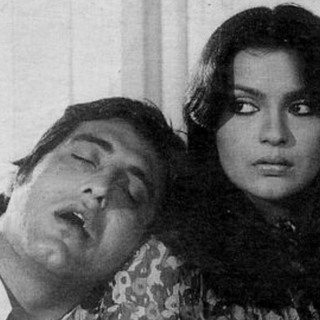
‘Tick, Tick… BOOM!’ Is a Tragedy About Time, but It Doesn’t Ask Who Gets To Have It
Against the backdrop of the devastating AIDS epidemic, the autobiographical musical about Jonathan Larson doesn’t ask whose ambition can survive time.

Tick, Tick…BOOM! is by all accounts, a good musical — one that I personally enjoyed. It was easy to get lost in its euphoric song and dance, its-foot tapping numbers making the drudgery of everyday life just a little easier to bear and its ballads serving as piercing cries for love, longing, and happiness in a world where they’re hard to come by and hard to keep. The film musical, directed by Lin-Manuel Miranda of Hamilton fame, is an adaptation of an autobiographical stage musical of the same name by Jonathan Larson, a young theatre genius behind one of Broadway’s most enduring runaway hits Rent.
The idea of time is, quite literally, the film’s beating heart. The “tick tick” of the clock can be juxtaposed against the steady pulsing of a vein in that both speak to the urgency of living life to the fullest in the here and the now, while there is life still coursing through us. Tick, Tick… is also a modern tragedy about running out of time, or being haunted by the feeling of it as we navigate our passion, creativity, and ambition. But a closer look at the film’s backdrop reveals the musical’s fatal flaw — one that it shares with most contemporary musicals. It is that an individual’s character arc, their trials and tribulations, are made out to be all the richer while riding on a societal problem that doesn’t directly affect them.
Tick, Tick… takes place amid the devastating and deadly AIDS epidemic in America. In the story of Larson’s creative journey, his quest to be seen and the desire to make art that matters drive his story forward.
There is a scene from a house party that has all the trappings of an upbeat, hopeful, bohemian vibe. The song “Boho Days” speaks to resisting difficult odds through sheer force of will, passion, and creative freedom. It is followed by another whose refrain “Is this real life,” throws back to “Bohemian Rhapsody,” Queen’s smash hit that epitomizes the spirit of unfettered theatricality in art. But the only person who ultimately gets to realize any of these bohemian ideals is Larson himself.
Even as everyone struggles with a sense of time running out — most of all Larson — he is the only one who can hold on to his ambition and run with it for the time he has left. Because there is nothing immediately foreseeable to bookend it from the other side. The same cannot be said for his friends — mostly all people of color who had their own artistic dreams but who do not have the same luxury to hold on to them for dear life. Looming against them all is the AIDS epidemic, the air of mistrust and taboo, the government insinuations against “homosexuals” getting their due for violating nature, the structural violence carried through whispers in the air. Some of Larson’s friends die. Others are forced to “sell out” and take up corporate jobs.
Related on The Swaddle:
The film does cast a critical gaze on Larson during scenes when he berates his best friend for wanting a nice car and a house over doing something “meaningful.” But what it doesn’t do, and what indeed so many musicals don’t do, is remove the lens of the privileged protagonist while viewing a social problem that doesn’t affect them. Who gets to have ambition? Whose mortality is more fragile? And why? These are questions that, rather than asking, musicals like Tick, Tick… gloss over, making the experience of being young and running out of time a universalized narrative when it isn’t.
This is true of Larson’s subsequent hit Rent and its film adaptation too. Film critic Lindsay Ellis in a video essay points out how “it advocates for no revolution, other than the revolution of whatever makes *you* as an individual feel good… Rent takes an inherently political issue and depoliticizes it to create something comforting and consumable.”
And this, ultimately, is the problem with musicals as a genre. They make for comfortable viewing, even as they use extremely large and complex social issues as a stage for the theatre of the privileged. Miranda’s blockbuster success Hamilton — a musical that, like Rent, is credited with changing the way musicals are performed on Broadway — is a prime case in point. Taking a subject as contentious as America’s founding and whitewashing it of all its violence and decrepitude to tell the story of one of its founding father made many black and Native American critics raise several eyebrows, to say the least. This same sentiment is transposed almost exactly onto Tick, Tick… BOOM!.
The original play, of course, did not have the voiceover narration of what happened to Larson in the end — because Larson himself had no way of knowing it. This was an addition that Miranda made to contextualize the film, and add deeper meaning to Larson’s anxiety about running out of time. But to take this creative liberty specifically is to go further than the original in using the AIDS epidemic’s sorrow and loss to underscore the finitude and mortality of a “great” white heterosexual man.
To be sure, the angst of young people buzzing with ideas and ambition, sacrificing everything at the altar of meaningful creative expression, and desperately seeking to be seen and heard before their time runs out is a relatable feeling. But the problem arises when, consistently, we are only shown how people with the least to lose get to experience this feeling against the backdrop of violence against those whose dreams are shattered by forces much bigger than them. The film adaptation of Tick, Tick…BOOM! made a choice to end as a tragedy of time being cut short, when the original was far more triumphant and hopeful.
By inserting more biographical detail into it, Miranda made the theme of actually running out of time during the AIDS epidemic about a man who wasn’t directly affected by it. And when Miranda chose to do this, he also chose not to delve further into the systemic failures that caused this scarcity of time in the first place. In making these choices, he did the same thing he did in Hamilton, which is to gloss over the inconvenient details about society in service of making a poignant biography of underrated genius men.
And this, ultimately, leaves a strange taste after the credits roll. Whose time was actually cut short? What happened to Michael, Larson’s best friend who “sold out” in order to live better while he could? What happened to Susan, his girlfriend who sought a quieter outlet for her creativity? What about Freddy, his friend and fellow-artist from the diner whom we last saw in the hospital? Did he make it? Did anyone else make it? Who tells their stories, and who rescues them from the archives of time?
These are questions that are unique to Miranda’s adaptation and that follow from an established pattern we’ve seen with him before. The conflict between ambition and mortality may be eternal, but it is time to tell the story of this conflict waged by people who have a lot more to lose. Or, at the very least, not relegate them to the footnotes of the histories of white men. As Miranda himself put it: who lives, who dies, who tells your story?
Rohitha Naraharisetty is a Senior Associate Editor at The Swaddle. She writes about the intersection of gender, caste, social movements, and pop culture. She can be found on Instagram at @rohitha_97 or on Twitter at @romimacaronii.
Related


The Buzz Cut: Government Unwittingly Makes Privileged Comedian the Face of India’s Problems
